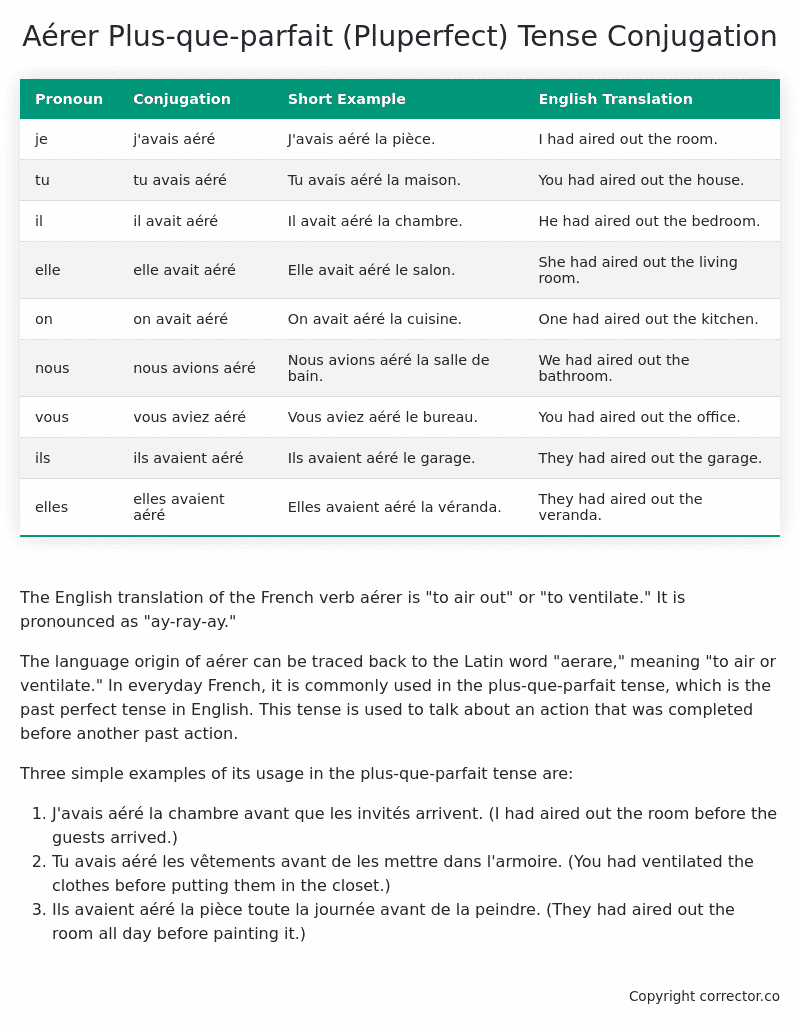Plus-que-parfait (Pluperfect) Tense Conjugation of the French Verb aérer
Introduction to the verb aérer
The English translation of the French verb aérer is “to air out” or “to ventilate.” It is pronounced as “ay-ray-ay.”
The language origin of aérer can be traced back to the Latin word “aerare,” meaning “to air or ventilate.” In everyday French, it is commonly used in the plus-que-parfait tense, which is the past perfect tense in English. This tense is used to talk about an action that was completed before another past action.
Three simple examples of its usage in the plus-que-parfait tense are:
- J’avais aéré la chambre avant que les invités arrivent. (I had aired out the room before the guests arrived.)
- Tu avais aéré les vêtements avant de les mettre dans l’armoire. (You had ventilated the clothes before putting them in the closet.)
- Ils avaient aéré la pièce toute la journée avant de la peindre. (They had aired out the room all day before painting it.)
Table of the Plus-que-parfait (Pluperfect) Tense Conjugation of aérer
| Pronoun | Conjugation | Short Example | English Translation |
|---|---|---|---|
| je | j’avais aéré | J’avais aéré la pièce. | I had aired out the room. |
| tu | tu avais aéré | Tu avais aéré la maison. | You had aired out the house. |
| il | il avait aéré | Il avait aéré la chambre. | He had aired out the bedroom. |
| elle | elle avait aéré | Elle avait aéré le salon. | She had aired out the living room. |
| on | on avait aéré | On avait aéré la cuisine. | One had aired out the kitchen. |
| nous | nous avions aéré | Nous avions aéré la salle de bain. | We had aired out the bathroom. |
| vous | vous aviez aéré | Vous aviez aéré le bureau. | You had aired out the office. |
| ils | ils avaient aéré | Ils avaient aéré le garage. | They had aired out the garage. |
| elles | elles avaient aéré | Elles avaient aéré la véranda. | They had aired out the veranda. |
Other Conjugations for Aérer.
Le Present (Present Tense) Conjugation of the French Verb aérer
Imparfait (Imperfect) Tense Conjugation of the French Verb aérer
Passé Simple (Simple Past) Tense Conjugation of the French Verb aérer
Passé Composé (Present Perfect) Tense Conjugation of the French Verb aérer
Futur Simple (Simple Future) Tense Conjugation of the French Verb aérer
Futur Proche (Near Future) Tense Conjugation of the French Verb aérer
Plus-que-parfait (Pluperfect) Tense Conjugation of the French Verb aérer (this article)
Passé Antérieur (Past Anterior) Tense Conjugation of the French Verb aérer
Futur Antérieur (Future Anterior) Tense Conjugation of the French Verb aérer
Subjonctif Présent (Subjunctive Present) Tense Conjugation of the French Verb aérer
Subjonctif Passé (Subjunctive Past) Tense Conjugation of the French Verb aérer
Subjonctif Imparfait (Subjunctive Imperfect) Tense Conjugation of the French Verb aérer
Subjonctif Plus-que-parfait (Subjunctive Pluperfect) Tense Conjugation of the French Verb aérer
Conditionnel Présent (Conditional Present) Tense Conjugation of the French Verb aérer
Conditionnel Passé (Conditional Past) Tense Conjugation of the French Verb aérer
L’impératif Présent (Imperative Present) Tense Conjugation of the French Verb aérer
L’infinitif Présent (Infinitive Present) Tense Conjugation of the French Verb aérer
Struggling with French verbs or the language in general? Why not use our free French Grammar Checker – no registration required!
Get a FREE Download Study Sheet of this Conjugation 🔥
Simply right click the image below, click “save image” and get your free reference for the aérer Plus-que-parfait tense conjugation!

Aérer – About the French Plus-que-parfait (Pluperfect) Tense
Tense Formation
Common everyday usage patterns
Sequencing of past events
Background information
Hypothetical or reported speech
Interactions with other tenses
Summary
I hope you enjoyed this article on the verb aérer. Still in a learning mood? Check out another TOTALLY random French verb conjugation!


